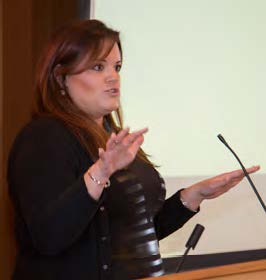Telling Your Leadership Story

NYCHA Now continues its “employee voices” series with articles by employees about initiatives and events that they know best. To submit an article about a topic you care about, please contact NYCHANow. We want to hear from you!
What did Apple’s Steve Jobs and my 91-year-old grandfather have in common? They were both excellent storytellers. They knew a good story could teach, motivate, and leave a lingering impact long after they were gone. Leaders like Steve Jobs (and yes, even my grandpa) understood people aren’t always logical. Reason doesn’t always inspire action or change—but stories could influence and drive people towards a shared, logical goal.
Researchers have found that a good story can produce oxytocin in the brain, a chemical that syncs people by fostering bonding, empathy, trust and cooperation. It’s the science behind storytelling that explains why many of the most effective leaders and those in leadership roles use storytelling as a communication tool.
Every day, NYCHA employees are working to make real, meaningful change in a million different ways under NextGeneration NYCHA. Like an engine, each widget and component must be synced to power us forward. But until the nuts and bolts (policies, trainings, equipment and other functional pieces) are changed or upgraded to meet NextGen goals, how can we as employees and leaders also change mindsets, motivate and ‘power’ teams? Storytelling.
Compelling stories aren’t fables, overly long or complicated. They can be personal, but they don’t have to be. The best stories are relatable; they inspire action, teach a lesson, or define the value of the work at hand.
Stories have the ability to reach people in ways that logical arguments or directives cannot. A good story can breathe life into facts and figures and stick with a person well after a presentation is over or a training session has been completed. For leaders, a story puts “the what” into context to illustrate the why and the how of our work here at NYCHA.
I can say customer service means treating people like family or I can tell you a story about Felix, a caretaker who checks on a senior resident every morning when he’s making his rounds to make sure she’s okay. Or like the profound impact an incident had on a property manager after she jumped to action to save a resident’s life after hearing the working smoke detector—to illustrate the policy to do safety checks in apartments during every visit. The point of the story is to connect the audience to the work, why and how we approach our jobs as NYCHA employees.
Every day, there are countless stories and moments that breathe life into NextGeneration NYCHA, which make it real. It’s our job as leaders to identify these stories and repeat them not just for positive recognition but for coaching, training and bringing everyone on the team into the unified vision of NYCHA.
Here’s some homework to hone your own leadership and communication skills through storytelling. Try in staff meetings, training sessions, or your next PowerPoint presentation to use a story to reinforce data in real-life terms, as a form of coaching or a way to move people on your team to action. The basics of a good story include an overall takeaway message, are brief and relatable, and give a sense of people or place. If you inspire a connection or action through your story, you’re doing it right.







